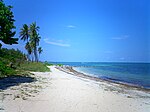Miami Seaquarium
1955 establishments in FloridaAquaria in FloridaBuildings and structures in MiamiLandmarks in FloridaOceanaria in the United States ... and 4 more
Parques ReunidosTourist attractions in MiamiUse mdy dates from February 2013Wometco Enterprises

The Miami Seaquarium is a 38-acre (15 ha) oceanarium located on the island of Virginia Key in Biscayne Bay, Miami-Dade County, Florida located near downtown Miami. Founded in 1955, it is one of the oldest oceanariums in the United States. In addition to marine mammals, the Miami Seaquarium houses fish, sharks, sea turtles, birds, reptiles, and manatees. The park offers daily presentations and hosts overnight camps, events for boy scouts, and group programs. Over 500,000 people visit the facility annually. The park has around 225 employees, and its lease payments and taxes make it the third-largest contributor to Miami-Dade County's revenue.
Excerpt from the Wikipedia article Miami Seaquarium (License: CC BY-SA 3.0, Authors, Images).Miami Seaquarium
Rickenbacker Causeway,
Geographical coordinates (GPS) Address Nearby Places Show on map
Geographical coordinates (GPS)
| Latitude | Longitude |
|---|---|
| N 25.733 ° | E -80.165525 ° |
Address
Top Deck Dolphin Show
Rickenbacker Causeway
33109
Florida, United States
Open on Google Maps





